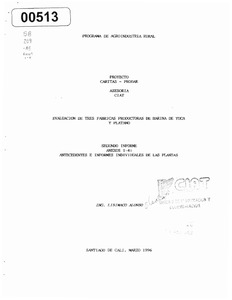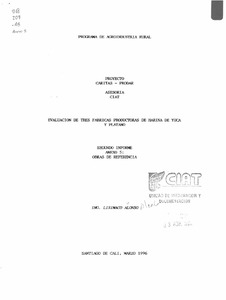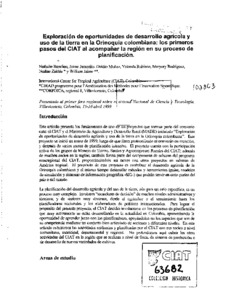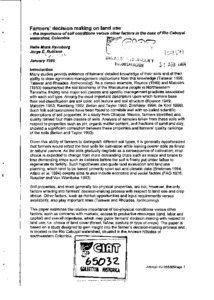Utilización de la tierra
AGROVOC URI:
Evaluación de tres fábricas de harina de yuca y plátano - SEGUNDO INFORME ANEXOS 5
Evaluación de tres fábricas de harina de yuca y plátano - SEGUNDO INFORME ANEXOS 6
Evaluating adoption of new crop-livestock-soil-management technologies using georeferenced village level data: the case of cowpea in the dry savannahs of West Africa
The present study uses georeferenced community level data to study the adoption of improved cowpea in northern Nigeria. One objective of this study is to find out which factors of the community of village level are significant determinants of adoption of improved dual-purpose (DP) cowpea variaties and management techniques.
Exploring the potential of beneficial soil fungi to enhance productivity in agricultural systems
Exploración de oportunidades de desarrollo agrícola y uso de la tierra en la Orinoquia colombiana : Los primeros pasos del CIAT al acompañar la región en su proceso de planificación
Farmers` decision making on land use : The importance of soil conditions versus other factors in the case of rio Cabuyal watershed, Colombia
Factors influencing the incidence of the black bean aphid, Aphis fabae scop., on common beans intercropped with maize
The incidence of the black bean aphid, Aphis fabae check for this species in other resources scop. (Homoptera: Aphididae), and its colonization of common beans (phaseolus vulgaris L.) grown as sole crop and as intercrops with maize ( Zea mays check for this species in other resources L.) of varying growth stages was evaluated in the field and glasshouse. Modification of bean micro-climate and its effects on A. fabae, and the species range and abundance of coccinellid predators (Coleoptera: Coccinellidae) of the aphid were also assessed. Results showed that A.
Farming innovation for food security among the HIV/AIDS affected rural household in Western Kenya
Faecal excretion by ruminants and manure availability for crop production in semi-arid West Africa
Livestock manure is an important source of nutrients for crop production in semi-arid West Africa. An assessment of the potential of manure to sustain crop production calls for an estimation of the amounts of manure that could be produced and captured and the feed resources required to maintain livestock used for manuring. This paper presents estimates of the amounts of manure produced by cattle, goats and sheep fed ad libitum under confinement. A model is presented to predict the yearly faecal output by grazing ruminants under fluctuating feed supplies.
Farming secondary forests in Indonesia
Estimates of the area of swidden fallow secondary forest in Indonesia are inaccurate, partly because swidden agricultural practices giving rise to the secondary forest are heterogeneous. Throughout Indonesia, swidden agriculture is evolving into more intensive land use. A mixed secondary forest tree crop management appears to be the first stage towards a tree crop based production in Sumatra and Kalimantan. This changes the value of the forest/tree component of swidden agriculture, or the systems it evolves into.





